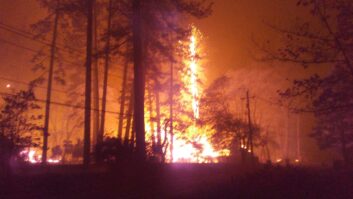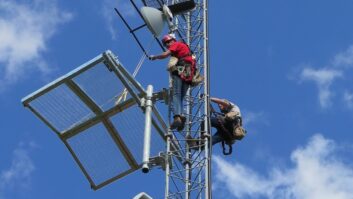
In this image from the MRHS website, Paul Zell sends the last commercial Morse messages at KFS/KPH (or so it was thought).
Several historic Morse Code stations will be on the air again Sunday evening July 12, though the future of the Coast Guard’s participation is unclear. I emailed with Paul Shinn, a member of the Maritime Radio Historical Society, for an update to what has become known as the “Night of Nights.”
RW: Briefly tell us what the Night of Nights is.
Shinn: The last commercial Morse message in North America was transmitted from KFS in Half Moon Bay, Calif., on July 12, 1999 at 00:00 GMT (1700 hrs Pacific time). Morse was declared dead on that day.
On July 12, 2000 (the first anniversary of that alleged last message), with the support of the Point Reyes National Seashore, and Globe Wireless, the Maritime Radio Historical Society brought KPH back to life on its original commercial frequencies, using the original transmitters and antennas. It was an emotional moment as the once abandoned station returned to the air, an event we came to call the “Night of Nights.”
Night of Nights has since become a tradition. Every year since, at 00:01 GMT, KPH has returned to the air to pick up the thread, keep the faith and carry on with the tradition of maritime Morse in honor of the men and women who came before us. Other stations have joined us on the air for this event including WLO in Mobile, Ala., and KLB near Seattle, Wash. In the past USCG stations NMC, NOJ and NMN have joined in too. Listeners around the world wait with their earphones on to hear the marine bands once again populated with Morse signals. We receive many letters after these events, many of them quite emotional
RW: What is your own role in the event?
Shinn: I work at the transmitter site with a few Maritime Radio Historical Society colleagues. The transmitters reside at the former Marconi (later, RCA, then MCI) site near Bolinas, Calif. The oldest transmitter still on site is from the 1930s. The oldest operational transmitter is from 1942. Most of the vintage transmitters that will be on the air for Night of Nights are RCA units that were installed in the ’50s. Our “crown jewel” is an early ’60s vintage RCA “H set,” #298H, that was lovingly restored largely by an incredible group of retired HP engineers who joined our group. 298H was just one of what used to be hundreds of H sets installed at each end of point-to-point circuits worldwide. 298H is believed to be the last operational H set left in the world. It takes a team to wake them all up and keep them on the air.
RW: Why does this event have such lasting appeal in radio history/radio tech circles?
Shinn: We take great pride in the history of the stations, the amazing operators and the role they played in the world. For example, the message that Pearl Harbor was under attack came through our station on its way to the White House and the nation. We are also somewhat smug in the knowledge that the satellite system that eventually replaced land based ship to shore communications has no backup plan, except for us.
Besides that, Morse is “music,” and Morse (CW) was digital before digital was cool.
RW: You mentioned that the event may see a change in the future. Why? And when would we know?
Shinn: This year, as in the past, several Coast Guard stations join in the Night of Nights on-air festivities. However, as the Coast Guard communications stations are being upgraded or modernized, they are not doing so with Morse capabilities in mind. Also, as those stations are increasingly automated and unattended, many of the skilled operators are retiring or taking different assignments, and there are fewer ops capable of communicating via Morse. Therefore, we know that they will not have the capability to participate in the future. In fact, a little bird tells us, this may be the last opportunity to ever hear a U.S. Coast Guard station on the air in A1 mode.
As for when would we know; well, when you don’t hear them anymore, then we know.
RW: What’s your favorite memory from past nights?
Shinn: Getting to work with the people at the stations is such a pleasure, and we have so much fun. I actually have two favorite moments.
First, about six years ago, I was in the OSHA climbing harness, hanging from some support beams along one wall of the upper transmitter galley, moving some open wire feedlines around to enable another vintage transmitter. All the open wire feedlines exit through one of two walls on the north or south side of the building. Although the feedline I was working on was not going yet in use, there are a LOT of feedlines all around. It was about five minutes until the NoN transmissions were scheduled to start, and all the transmitters were filaments and plates ON, ready to go. Transmitter Supervisor Steve Hawes casually walked out to the area where I was working and with his typical super-calm, deadpan delivery said, “You might want to finish that up. There’s about to be a lot of RF flying around.”
Second story; Two years ago, one of the ’50s vintage RCA transmitters on 6 MHz was having some fits during the pre-NoN testing, but Steve Hawes and I managed to find a happy medium in time for the start of the broadcasts. At the end of the night, the stations send a benediction message, keyed from the transmitter site. During this message, everyone is in the control room, watching the message being keyed by hand, and taking it all in. It is a very somber moment. Five seconds after the final signoff, when everyone was still silent, there was a BANG! in the transmitter galley. The 6 MHz RCA hung on as long as it could, but let go immediately after the AR (last thing you hear for the whole night) was sent. Perfect timing. We all laughed so hard, we were in tears. We repaired the transmitter in plenty of time for the next NoN.
RW: Anything else that a Radio World reader should know?
Shinn: Anyone with a shortwave receiver that has a BFO, CW or SSB capability can tune in and hear the coast stations come alive for Night of Nights. For a list of frequencies that will be active, see the website.
RW: Can you share a past photo?
Shinn: Better yet, how about video? (Two are below).
Here’s a view of the transmitter galley from 2014.
And a closing message from 2010:











